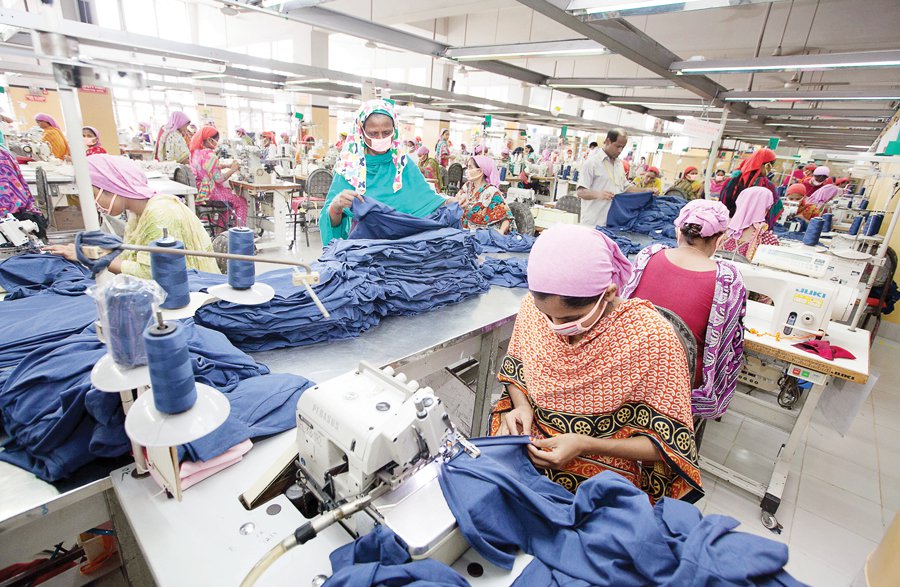Published in Dhaka Tribune on January 25, 2018

Photo: Mahmud Hossain Opu
Currently, Bangladeshi manufacturers mostly produce basic fabrics, which is not for higher-end products
Increased dependence on fabrics import and a lack of proper policy on energy supply are negatively impacting the competitiveness of Bangladesh’s woven garment exports in the global market.
Industry insiders and trade analysts have blamed longer lead time, poor backward linkage, the absence of value addition and modern technology and lack of proper policy support on gas and electricity connection for the decline.
According to the Export Promotion Bureau (EPB), export earnings from the woven garment products have seen a 2.35% fall in the last fiscal year to $14.39 billion.
It has, however, posted a 4% growth in the first half of the current fiscal to $7.17 billion. During the same period, knitwear products earning has seen an 11.47% rise to $7.6 billion.
The woven sector has also seen negative growth in major export destinations including Germany and the US, two of the largest export destinations.
Experts have suggested new investments in backward linkage to reduce import dependence and technology upgradation for value addition in order to make a comeback.
Lack of competitiveness
To boost export of woven garments, the issue of longer lead time caused by import dependence is a key factor while the price edge is another important element.
“Bangladesh is doing better in knit products exports. This is because of we have strong backward linkage industry,” Faruque Hassan, BGMEA senior vice president told the Dhaka Tribune.
“However, woven products manufacturers are highly dependent on import for fabrics, which costs more. As a result, export earnings from woven goods have seen slower growth and it is losing its strength in the global market,” he added.
On the other hand, value addition of woven products is less than the knit products which led to lower prices, Hassan said.
“We do not have manmade fibre, polyester and petrochemical, which we have to import. We will be competitive if we can meet the demand from the local sources,” he added.
“Stakeholders are investing to upgrade machinery to go value addition. This will boost the buyers’ confidence and they will place orders for higher end woven products in Bangladesh,” the BGMEA senior vice president said.
The challenges
Shorter lead time is the key to remaining competitive in the global market. To reduce the lead time, Bangladesh has to improve its backward linkage industry to meet the demands locally.
It takes about 35 days to ship goods to the US from Bangladesh. But shipping from China takes 20 days and it is 15 days for Turkey, Exporters Association of Bangladesh president Abdus Salam Murshedy noted.
“As a result, Bangladesh cannot take urgent orders from buyers due to longer lead time,” he told the Dhaka Tribune.
While getting a gas connection is a big challenge, business will not be viable if the manufacturers have to run a factory with diesel instead of gas.
“Only using gas can make the production less expensive, which will help us be competitive,” he said, urging a proper energy policy for the sector.
The size of investment and costs of land are two other challenges. “Setting up woven fabric factories cost two to three times more than establishing a knit composite factory,” Salam said. “It also needs more land.”
Ways forward
Bangladesh can only meet 30% to 35% of local demands of woven fabrics. So, there is a huge gap between the supply and demand of woven fabrics. It is clear that there is big opportunity to grow by making new investments.
“First, we have to try to meet the demands locally to reduce lead time as it takes so many days to import fabrics. For this, new investment is a must to increase production capacity in line with the demands,” said Salam, also managing director of Envoy Textile.
“Then, the government should ensure infrastructure to ship finished goods within a possible shorter time as it is the key to success to grab more orders and remain competitive in the global market,” he added.
The former BGMEA president said there were many capable investors but they were unwilling to make investments due to lack of proper policy support and utility services.
“Losing market share of woven garments is alarming for Bangladesh as over 82% export earnings come from apparel sector and the woven sector contributes almost half of it,” former caretaker government adviser AB Mirza Azizul Islam told the Dhaka Tribune.
“We have to ensure balanced export earnings to attain a sustainable exports growth,” he said. “The government, along with the stakeholders, should jointly take steps to overcome the challenges.”
He said he believed that new investment could improve the industry capacity to meet the demand of fabrics locally.
Currently, Bangladeshi manufacturers mostly produce basic fabrics, which is not for higher-end products.
“Since the fashion trend is changing every day and the consumers want latest fashion products, the clothing retailers are looking for more technical fabrics instead of basic ones. To cope up with the latest demand, we should focus on multifunctional fabrics to diversify products,” Md Mostafiz Uddin, managing director of Denim Expert Limited, told the Dhaka Tribune.
He also suggested product development by research and innovation as well as introducing technology in manufacturing to get higher prices.
 CPD RMG Study Stitching a better future for Bangladesh
CPD RMG Study Stitching a better future for Bangladesh



